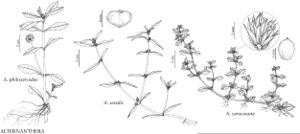Alternanthera philoxeroides
Abh. Königl. Ges. Wiss. Göttingen 24: 36. 1879.
Herbs, perennial, aquatic to semiterrestrial, stoloniferous, to 50 dm. Stems prostrate, forming mats, often fistulose, glabrous. Leaves sessile; blade narrowly elliptic, elliptic, or oblanceolate, 3.5–7.1 × 0.5–2 cm, herbaceous, apex acute to obtuse, glabrous. Inflorescences terminal and axillary, pedunculate; heads white, globose, 1.4–1.7 cm diam.; bracts not keeled, less than 1/2 as long as tepals. Flowers: tepals monomorphic, white, lanceolate or oblong, 6 mm, apex acute, glabrous; stamens 5; pseudostaminodes ligulate. Utricles not seen. Seeds not seen.
Phenology: Flowering early spring–summer.
Habitat: Ponds, ditches, streams, bayous
Elevation: 0-200 m
Distribution

Ala., Ark., Calif., Fla., Ga., Ill., Ky., La., Miss., N.C., S.C., Tenn., Tex., Va., West Indies, native to South America.
Discussion
Alternanthera philoxerioides is said to reproduce only vegetatively in North America. I have seen no fruit or seed.
Selected References
None.
